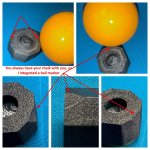Here is a ball marker @iusedtoberich and I designed and he had made in China in brass and aluminum.
The ball contacts the marker on the flat, sloped surface on each leg. This allows it to work for various sizes of balls. (Markers with semi-circular shapes have a problem with this.)
If you nest two of them, the hole of the inner one is the position of the base of a ball that was sitting against the outer one. This allows you to place a ball exactly on a spot or to mark a spot where the ball was sitting.
The legs are the length of the radius of a ball. This allows you to see if a ball will spot or if its edge is over a line. This also means the marker is fairly small.
I really like the brass version. The aluminum is a little light to stay put.
This is overkill for most people but referees need to do those things sometimes. Usually a piece of chalk is OK.

The ball contacts the marker on the flat, sloped surface on each leg. This allows it to work for various sizes of balls. (Markers with semi-circular shapes have a problem with this.)
If you nest two of them, the hole of the inner one is the position of the base of a ball that was sitting against the outer one. This allows you to place a ball exactly on a spot or to mark a spot where the ball was sitting.
The legs are the length of the radius of a ball. This allows you to see if a ball will spot or if its edge is over a line. This also means the marker is fairly small.
I really like the brass version. The aluminum is a little light to stay put.
This is overkill for most people but referees need to do those things sometimes. Usually a piece of chalk is OK.




